Since time immemorial, humans have aspired to reach further, and the moon was marked as the first goal. Armstrong and Aldrin walked on the moon more than a year ago־47 years, and the next goal is to settle it. And not only him: Mars appears to be the desired destination. On the great challenge of humanity - to find it another home
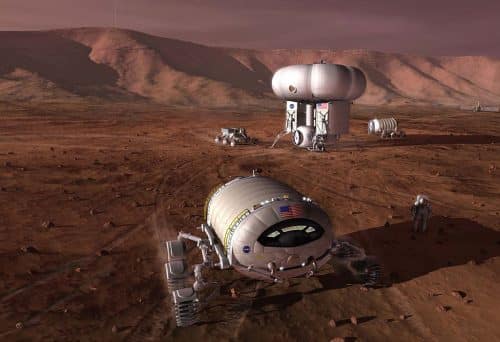
Written by: Zvi Atzmon, Young Galileo
The two worlds closest to us, on which it is possible to land manned spacecraft and on which humans can exist under certain conditions, are the Moon and Mars. Humans managed to land on the moon more than 47 years ago, and the race to Mars is in full swing.
The human desire to reach these distant regions comes from several motives. First of all, humans are known to be curious and ambitious: whoever succeeds in this will be highly regarded, respected and prestigious - just like the first astronauts were. Apart from that, colonization on the Moon and Mars will enable a thorough study of them. According to one of the theories, the moon originated from a fragment that splashed from the ancient earth, following its collision with another celestial body, so that the moon preserves important details about the structure of the ancient earth; And a Mars explorer will help find out if there is any life on it or if there was any in the past.
Telescopes can be placed on the moon in different wavelength ranges: X-ray radiation, violet radiation, infrared radiation, and more - because it does not have an atmosphere that blocks these types of radiation. Apart from that, since the Moon and Mars are smaller and have a smaller mass than the Earth, it will be easier to launch spaceships from them into space. Hence the importance of permanent bases on the moon and Mars. Another motive is that from the Moon and Mars it is possible to extract materials that are needed on Earth as well as raw materials that will be used to build permanent outposts on them, including residential buildings.
One of the other claims concerns the distant future, according to which humanity must find new worlds to live in. According to this claim, the existence of all humanity in a single celestial gram - the Earth - is a dangerous situation. If, God forbid, a massive disaster occurs on Earth, all of humanity could become extinct, as apparently happened to the dinosaurs following an asteroid impact about 66 million years ago. On the other hand, if humanity exists in two or more celestial bodies, it will not be completely extinct from a fatal impact on one of them.
conditions for sustaining life
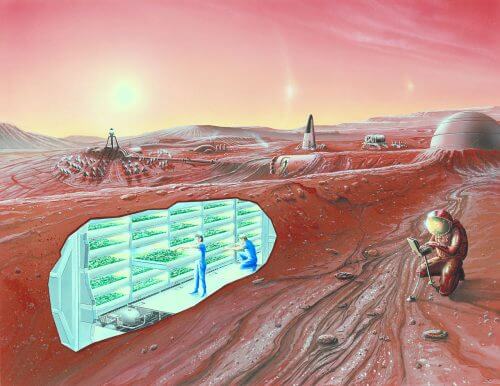
In order for us to exist on the moon or on Mars, we must take care of several essential needs: air pressure, oxygen, preventing a dangerous increase in the concentration of carbon dioxide, water, food, energy, protection from harmful radiation and damaging meteorites, medical and emergency services, and also a solution to feelings of disconnection and loneliness
Air pressure is required to prevent water from boiling, which is a significant percentage of our body. As the external pressure decreases, the boiling temperature decreases, and at a pressure of about 6 percent of normal atmospheric pressure, water boils at body temperature, 37 degrees. In such a situation it is of course impossible to live; Oxygen is required for breathing; Carbon dioxide is created as waste in the breathing process of the body's cells, and a noticeable increase in its concentration is very dangerous; Energy is needed to regulate the temperature of the environment, as well as for lighting, communication, growing and preparing food, producing materials and products, communication and more.
Landing and life on the moon
Establishing a settlement on the moon has several advantages: first of all, it is possible - humans have already been on the moon and returned safely. The flight time is a few days, and this allows for emergency operations if necessary. Radio communication is also simple: radio waves take a little more than a second to reach the moon from the earth and vice versa.
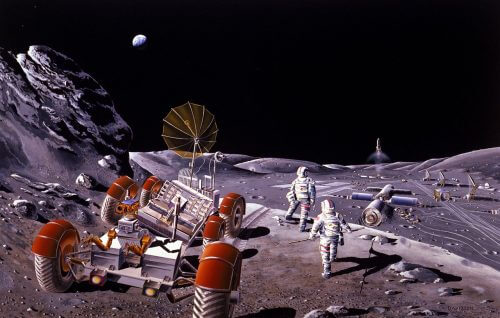
However, the challenges that the moon poses for maintaining a permanent settlement are not simple: the moon lacks an atmosphere, and therefore does not provide air pressure and oxygen for breathing; There are extreme temperature differences on its surface; The lack of atmosphere poses a danger of being hit by meteorites; And the moon is arid - there is no liquid water on it.
The rotation of the moon on its axis is very slow; This - together with the orbit around the sun, is the reason why the night in it lasts more than two weeks (354 hours)! This is expressed in huge temperature differences: for example, in the equatorial region of the moon the temperature drops at night to minus 150 degrees and even less, and during the day it rises to 110 degrees! Below the ground, the temperature differences are much smaller (and the temperature is low, about minus 20 degrees), so the solution could be the construction of underground buildings. These will be able to partially help in dealing with the temperature differences, as well as with the problems of harmful radiation and the impact of meteorites.
The long night also creates a problem of utilizing solar energy as an energy source. A possible solution for this is settlement near one of the poles of the moon. Any point in the polar regions that is covered by night is not far from an area where it is day at that time, and therefore it is possible to transfer electricity produced from solar energy to it. Besides this, there are areas at the poles raised from the surface where the sun is continuously visible even at night. And another advantage: it seems that inside the deep craters in the polar regions there is water ice - and water is an essential resource.
Another problem is that the surface of the moon is very poor in nitrogen and carbon, which are essential for growing food and industry; And another problem: the solar wind - which is a stream of electrically charged particles that are emitted from the sun at enormous speeds - can cause the development of electrical voltage that could damage the functioning of electronic devices.
Landing and life on Mars
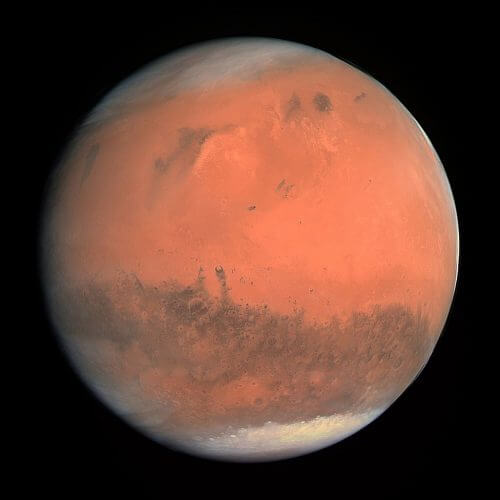
Mars is the known celestial body whose conditions are most similar to those prevailing on Earth, and it is also relatively close to us. A human foot has yet to set foot on Mars, although automated space vehicles have operated and are operating on it with great success.
Mars is similar to Earth in several characteristics: it has solid ground; Its area is almost equal to the terrestrial area of the Earth; His day is similar in length to ours (24 hours and 39 minutes); The inclination of the axis of self-rotation of Mars in relation to the plane of the Sun's orbit is similar to that of the Earth, which means that Mars also has seasons. However, Mars' year is longer (687 days) due to its farther orbit from the Sun. Its poles are also covered in ice, but besides frozen water ice they also have "dry ice" - frozen carbon dioxide.
But of course there are also quite a few challenges in life on Mars: its atmosphere is extremely thin and its pressure is not enough to prevent body water from boiling. Therefore, an environment will be required in which a pressure suitable for human life will prevail; The atmosphere also does not provide the oxygen needed for breathing - they will have to produce oxygen by breaking down water using an electric current (electrolysis) or with the help of photosynthetic organisms, such as plants, algae or photosynthetic bacteria. Apart from that, in the atmosphere of Mars, a concentration of carbon dioxide is toxic to humans, and even to plants; Mars is about 1.5 times farther from the sun than Earth, so only sometimes (in the summer, in the equatorial region) do the temperatures rise above zero degrees; There is no liquid water on Mars. Most of the water is stored in the form of ice at the poles and below the surface.
More difficulties: the gravity (gravitation) on the surface of Mars is 38 percent of that of the Earth, but the density of the atmosphere is only about 0.6 percent of that of the Earth. Hence, ordinary parachutes will not be sufficient for deceleration and landing on Mars, and the development of special means of landing will be required; Due to the thinness of the atmosphere, the surface of Mars is exposed to harmful ionizing radiation and ultraviolet radiation, and it will be necessary to protect against them. One of the solutions is underground buildings.
Apart from that, due to the great distance between the Earth and Mars there are also communication problems: the shortest distance between them is about 55 million kilometers, and the maximum - about 400 million kilometers, a distance that radio waves take between three and 22 minutes to travel. For the same reason, a control center on Earth will not be able to give an immediate response, for example to a problem when landing on Mars. Furthermore, during the period when the sun is between the Earth and Mars, it blocks the possibility of direct communication. This can be partially overcome by using a remote relay satellite from Mars.
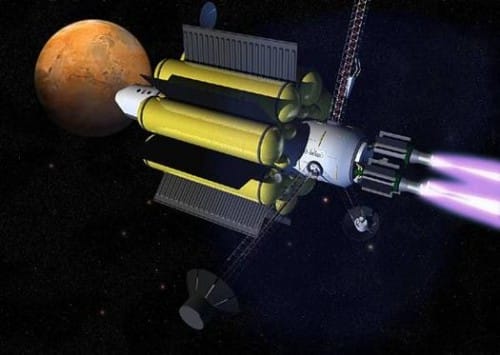
One of the most difficult problems is the length of the journey. With the existing technologies, a journey to Mars will take eight to nine months, in a small spacecraft, with a feeling of isolation and crowding and while being exposed to dangerous radiation. This problem should probably be solved thanks to modern propulsion methods, including Vasimair engines that use radio waves to ionize gas, and accelerate the ions to an ejection nozzle using strong magnetic fields. With such a method, a trip to Mars will last about a month, and in the distant future maybe even less.
One of the long-term, pretentious, and some argue - unrealistic plans, is the plan to "ground" Mars (from the language of Earth, the Earth): to turn the cold Mars, with little atmosphere and oxygen, into a second Earth. The intention is to find a way to increase the atmospheric pressure and oxygen level on Mars. Even if such a plan is possible, it is hundreds or perhaps thousands of years, if at all. However, we all hope to see the first humans walking on Mars - a dream that seems feasible in the coming decades, and yours, readers of Young Galileo, can be a real contribution as scientists, engineers, pilots and space pilots in the future.
The article was published in Young Galileo - the monthly for curious children. For a gift digital sheet Click

5 תגובות
Avi,
Your vision is very narrow and short-sighted. Mars needs to be settled first of all because it is not healthy to put all your eggs in one basket - we don't know what the future of the Earth is, we don't know if in six months or a year a large asteroid will hit the Earth and destroy all life here, or if a nuclear war will break out. In order to increase humanity's chance of survival, we must also start settling other places outside the earth.
As for the moon, let alone the fact that it is much smaller, it is also constantly changing its shape. Sometimes it's round, sometimes it's half, sometimes it's crescent-shaped... How can you live on a block of rock that changes its shape every day?
The same reason for climbing Everest, precisely because of the challenge
So how exactly can Mars (or any other planet) be settled when there are such differences in gravity? What does this mean about the ability to have children and reproduce on Mars? It doesn't seem possible.
Colonizing Mars is the most expensive and unnecessary thing man can do.
Maybe establish a station there for scientific research purposes but nothing more than that.
Colonizing Mars is not much better than colonizing the moon - it's just a desert rock mass with temperatures of minus one hundred degrees in the summer, without a significant atmosphere, without a magnetic field, exposed to radiation and the solar winds... - what is the logic of colonizing such a place?
It is much more practical to pour water and colonize the deserts on Earth, or build artificial islands in the sea...
It is easier to colonize Antarctica where it is only minus twenty degrees...
What are you looking for on Mars, when most of the Earth is uninhabited?
It will take at least another 100 years to start colonizing Mars